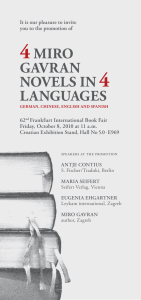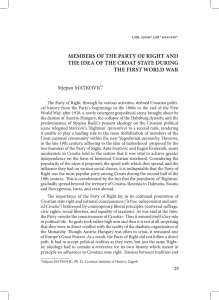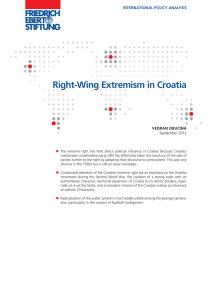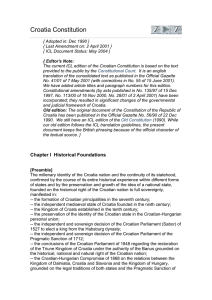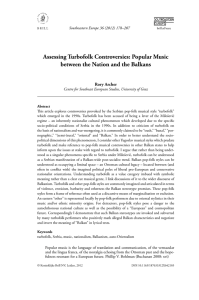Documento 15710
Anuncio
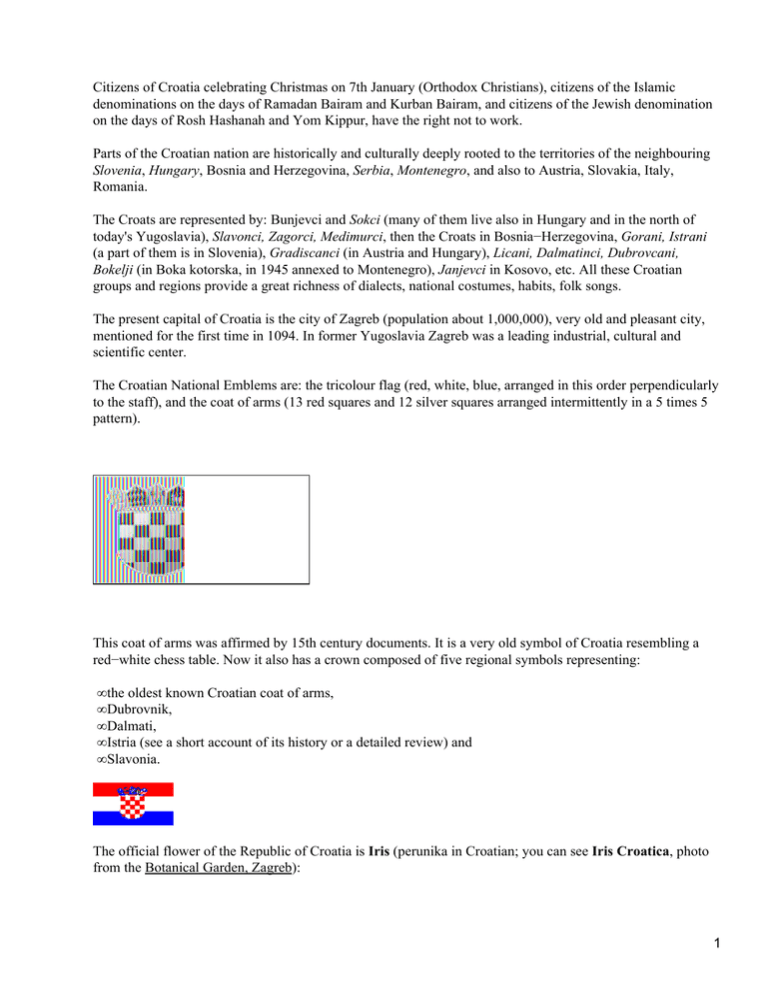
Citizens of Croatia celebrating Christmas on 7th January (Orthodox Christians), citizens of the Islamic denominations on the days of Ramadan Bairam and Kurban Bairam, and citizens of the Jewish denomination on the days of Rosh Hashanah and Yom Kippur, have the right not to work. Parts of the Croatian nation are historically and culturally deeply rooted to the territories of the neighbouring Slovenia, Hungary, Bosnia and Herzegovina, Serbia, Montenegro, and also to Austria, Slovakia, Italy, Romania. The Croats are represented by: Bunjevci and Sokci (many of them live also in Hungary and in the north of today's Yugoslavia), Slavonci, Zagorci, Medimurci, then the Croats in Bosnia−Herzegovina, Gorani, Istrani (a part of them is in Slovenia), Gradiscanci (in Austria and Hungary), Licani, Dalmatinci, Dubrovcani, Bokelji (in Boka kotorska, in 1945 annexed to Montenegro), Janjevci in Kosovo, etc. All these Croatian groups and regions provide a great richness of dialects, national costumes, habits, folk songs. The present capital of Croatia is the city of Zagreb (population about 1,000,000), very old and pleasant city, mentioned for the first time in 1094. In former Yugoslavia Zagreb was a leading industrial, cultural and scientific center. The Croatian National Emblems are: the tricolour flag (red, white, blue, arranged in this order perpendicularly to the staff), and the coat of arms (13 red squares and 12 silver squares arranged intermittently in a 5 times 5 pattern). This coat of arms was affirmed by 15th century documents. It is a very old symbol of Croatia resembling a red−white chess table. Now it also has a crown composed of five regional symbols representing: • the oldest known Croatian coat of arms, • Dubrovnik, • Dalmati, • Istria (see a short account of its history or a detailed review) and • Slavonia. The official flower of the Republic of Croatia is Iris (perunika in Croatian; you can see Iris Croatica, photo from the Botanical Garden, Zagreb): 1 Croatia has: • more than a thousand islands on the Adriatic sea, precisely − 1185 (66 inhabited); see also the beautiful Z. Skropanic web−site about Cro islands • as such − probably the most interesting coast in Europe (the name of the Adriatic see, as well as its Croatian version Jadran, seem to originate from the ancient name of a very old Croatian city Zadar − Yadera), • a mountain of unique and incomparable natural beauty − Velebit − one of the trademarks of Croatia, with unforgettable views to the islands and the mainland. It was recognized as a part of the international network of Biosphere Reserves (2,500 botanical species, 70−80 endemic), and was the victim of the Serbian aggression that started in 1991, • the most beautiful national park in Europe − the Plitvice Lakes (on the photo; devastated during the Serbian aggression on Croatia in 1991/92), • the richest bird reservation in Europe (until the Serbian aggression in 1991) − Kopacki Rit, near the city of Osijek, • among the world's most beautiful and best preserved medieval cities (victim of the Serbian aggression in 1991) − Dubrovnik (its Minceta tower is on the photo), • the smallest and loveliest town in the world − having city walls, two streets, two churches and 23 inhabitants − Hum, in the Istrian peninsula, • Vukovar, baroque city on the beautiful blue Danube, ferociously devastated in the autumn 1991, eternal monument of human destructiveness and human indifference. Five hundred thousand shells were fired by Serbian aggressors onto the area of only several square kilometers, inhabited by 15,000 people (normally 80,000), in the course of three months. National parks in Croatia: • the Plitvice lakes, also here; article by Zvonko Springer, Salzburg 2 • the Kornati islands, see also here (George Bernard Shaw once visited Kornati, and wrote the following "On the last day of the Creation God desired to crown his work, and thus created the Kornati Islands out of tears, stars and breath") • the Brijuni islands • the island of Mljet • the Krka river and its waterfalls, • the Velebit mountain, it has two and a half times more plant species than the entire Great Britain. • the Risnjak mountain. We would like to add several natural reserves: • the Biokovo mountain in Dalmatia, • Modro jezero near the town of Imotski, • Bijele and Samarske stijene, • Lonjsko polje near Zagreb, • Kopacki rit (Kopacevo Marshes) near Osijek. Especially important are rich resources of drinkable water of the highest quality: Photo by Don Wolf, USA: Images of Croatia (source CROWN) See also Urban parks in Croatia. You have for sure enjoyed breathtaking sceneries of natural beauties in films about Winnetou and Old Shatterhand, shot according to novels of Karl May. Maybe you did not know that these films were made in the Paklenica canyon, Plitvice lakes, and on Krka river. A friendly and very common greeting among the Croats in Croatia and Bosnia−Herzegovina is Bog!, both for Hi! and Bye!. The literal meaning of Bog is − God. So, Bog! Back to Croatia − an overview of its History, Culture and Science 3

